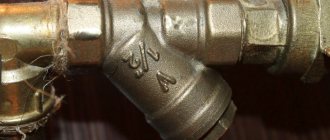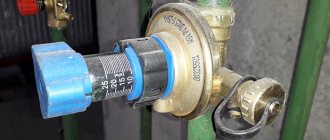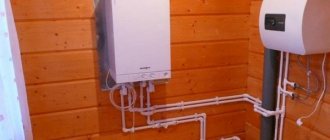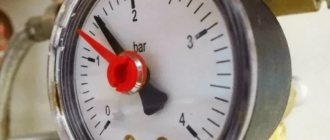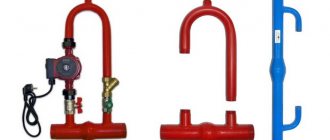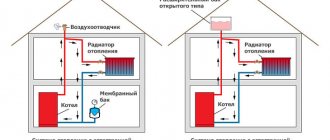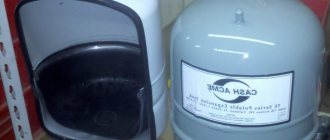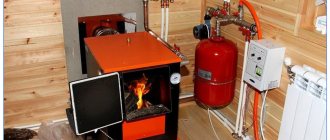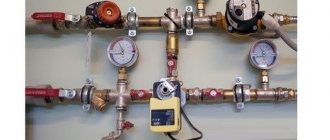Heating » Maintenance and faults
Published February 24, 2015 at 0:28 am
Any heating circuit operates at certain pressure and coolant temperature values, which are calculated at the design stage. However, during operation, situations are possible when the pressure drop in the heating system deviates from the standard level up or down and, as a rule, requires adjustment to ensure efficiency, and in some cases, safety.
Working pressure in heating systems
Working pressure is the value at which the normal functioning of the heating system is ensured, including the heat source, expansion tank, pump (for more details: “Working pressure in the heating system - standards and tests”). It is calculated in atmospheres (1 atmosphere is equal to 0.1 MPa).
The indicator should be equal to the sum of two pressures:
- static, created by a column of water (when carrying out, they are guided by the fact that there is 1 atmosphere per 10 meters);
- dynamic, due to the operation of the circulation pump and the convective movement of the coolant during heating.
The pressure indicator differs in different heating systems. For example, if the heat supply to a house occurs due to the natural circulation of the coolant (this option is possible in low-rise construction), then the pressure will be only slightly higher than the static pressure. And in systems with forced circulation it is much larger, which is necessary to obtain higher efficiency.
It should be taken into account that the maximum operating pressure of the heating system is determined by the characteristics of its elements. For example, when using cast iron radiators, it should not be more than 0.6 MPa.
The working pressure indicator is:
- for low-rise buildings with a closed layout - 0.2-0.4 MPa;
- for one-story buildings with natural coolant circulation and an open design - 0.1 MPa for every 10 meters of water column;
- for multi-storey buildings - up to 1 MPa.
Pressure drop monitoring
In order for the heating system to operate normally and the risk of an accident to be minimized, it is necessary to monitor the temperature and pressure of the coolant from time to time. For this purpose, a special pressure sensor is used in the heating system, as in the photo.
Most often, deformation pressure gauges with a Bourdon tube are used to measure pressure. When determining low pressure, a variety of them can be used - diaphragm devices. After water hammering, such models should be verified, since in subsequent measurements they may show inflated values.
In those systems that provide automatic control and regulation of pressure, various types of sensors are additionally used (for example, electric contact).
The placement of pressure gauges (tapping points) is determined by regulations. These devices should be installed in the most important areas of the system:
- at its entrance and exit;
- before and after filters, pumps, pressure regulators, mud traps;
- at the exit of the main line from the boiler house or thermal power plant and at its entrance to the building.
These recommendations must be followed even when creating a small heating circuit and using a low-power boiler, since not only the safety of the system depends on this, but also its efficiency, which is achieved through optimal fuel and water consumption (read: “Safety system for heating”). It is recommended to connect pressure gauges through three-way valves - this will allow you to purge, reset and replace devices without stopping the heating system.
Functions
First, let’s find out why the difference is created. Its main function is to ensure coolant circulation. Water will constantly move from a point with enormous pressure to a point where there is less pressure. The greater the difference, the greater the speed.
Useful: the limiting reason is the hydraulic resistance that increases with increasing flow velocity.
In addition, a difference is artificially created between the circulation connections of warm water supply into one thread (supply or return).
Circulation in this case performs two functions:
- Provides a consistently high temperature to heated towel rails , which in all modern buildings open one of the hot water supply risers connected in pairs.
- Guarantees a rapid flow of warm water to the mixer regardless of the time of day and water withdrawal through the riser. In dilapidated buildings without circulation connections, water has to be drained for a long time in the morning before it is heated.
Finally, the difference is created by modern water and heat consumption metering devices.
How and why? To answer this question, it is necessary to refer the reader to Bernoulli's law, according to which the static pressure of a flow is inversely proportional to the speed of its movement.
This gives us the opportunity to design a device that records water flow without the use of unreliable impellers:
- We pass the flow through the section transition.
- We record the pressure in the narrow part of the meter and in the main pipe.
Knowing the pressures and diameters, using electronics it is possible to calculate in real time the flow rate and speed of water flow; when using temperature sensors at the outlet and inlet of the heating circuit, it is easy to calculate the amount of heat remaining in the heating system. At the same time, based on the difference in flow rates on the supply and return pipelines, the consumption of warm water is calculated.
Pressure drop value for heating system
For the normal functioning of the heat supply, a certain pressure difference is required (the difference between the supply and return values of the coolant). Typically, pressure loss in a heating system is 0.1-0.2 MPa. When this indicator is less, this is a signal of a disruption in the movement of water through the pipelines, which is accompanied by ineffective heating (the coolant passes through the radiators without heating them to the required value). When the differential value is exceeded by more than 0.2 MPa, “stagnation” of the system begins, resulting from airing. A sharp change in pressure does not have the best effect on the functioning of individual elements of the heating structure, often causing their breakdowns.
Adjustment
How to adjust the pressure in the elevator unit?
Support washer
To be correct, when using a retaining washer, it is not necessary to adjust the pressure, but to periodically replace the washer with a similar one due to abrasive wear of the narrow metal sheet in process water. How to replace the washer with your own hands?
The instructions are generally quite simple:
- All valves or valves in the elevator are closed.
- One vent on the return and supply is opened to drain the unit.
- The bolts on the flange are loosened.
- Instead of the old washer, a new one is installed, equipped with a pair of gaskets - one on each side.
Tip: in the absence of paronitis, washers are cut from a dilapidated car inner tube. Don't forget to cut an eyelet that will allow the washer to fit into the flange groove.
- The bolts are tightened in pairs, crosswise. Once the gaskets are pressed, the nuts are tightened until they stop, no more than half a turn at a time. If you rush, uneven compression will certainly lead to the gasket being torn off by pressure from one side of the flange.
Heating system
The difference between the mixture and the return flow is normally regulated only by replacing, welding or drilling out the nozzle. But from time to time it becomes necessary to remove the difference without stopping the heating (in most cases, with important deviations from the temperature schedule during the peak of cold weather).
This is done by adjusting the inlet valve on the return pipeline; Thus, we remove the difference between the forward and reverse threads and between the mixture and the return.
- We measure the supply pressure at the end of the inlet valve.
- Switch the hot water supply to the supply thread.
- We screw the pressure gauge into the vent on the return line.
- We completely close the input check valve and then slowly open it until the difference decreases from the initial one by 0.2 kgf/cm2. Manipulation with subsequent opening and closing of the valve is necessary so that its cheeks descend as much as possible on the stem. If the valve is closed, the cheeks may sag in the future; the price of ridiculous time savings is at least defrosted access heating.
- The return temperature is monitored at daily intervals. If it is necessary to lower it further, the difference is removed 0.2 atmospheres at a time.
Pressure drop
If the pressure in the system drops, then most likely there is a coolant leak. The most vulnerable places are joints, seams and joints. To check, turn off the pump and observe changes in static pressure. If the pressure continues to decrease, you need to find the damaged area. For this purpose, experts recommend disconnecting different sections of the circuit, and after determining the location of the damage, replacing or repairing these elements.
If the pressure remains stable, a decrease in pressure may be due to a malfunction of the heating equipment or pump. A short-term drop in pressure sometimes occurs due to the operating characteristics of the regulator, which periodically releases part of the water from the supply to the return. If the radiators heat up to the required temperature, and evenly, then the pressure drop is due to the regulator. Also, reasons for low blood pressure may be:
- decrease in water temperature;
- removal of air through vents, due to which the volume in the coolant system decreases.
Increased pressure
If the maximum pressure in the heating system is exceeded, the reason for this is slowing down or stopping the movement of water in the heating circuit. This can lead to:
- contamination of mud traps and filters;
- the occurrence of an air lock;
- replenishment of the coolant due to an automatic failure or incorrectly adjusted valves located on the supply and return (read: “Automatic recharge of the heating system - diagram of the assembly and recharge valve”);
- a feature of the regulator or its incorrect setting.
Unstable pressure is especially common in recently installed heating systems due to the removal of air. This is considered normal if, after bringing the water volume and pressure to operating levels, no deviations are observed for several weeks. Otherwise, most likely, pressure instability is associated with incorrect hydraulic calculations, including insufficient volume of the expansion tank. That is why, when installing a heating system, it is important to correctly perform all the calculations - in the future this will eliminate various problems with its functioning.
What to do if the indicator rises above normal
Liquid, unlike gas (including air), is practically not compressible. When heated, the volume of the coolant increases. This must be taken into account when filling a refrigerated system.
There should be a free volume left in the communication, which will be filled with expanded liquid. If this is not done, after starting the heating, the pressure may increase above the safe level - the excess will pour out of the expansion tank of the gravity system or the emergency valve will operate in closed types of communication.
In the event of a malfunction, for example, jamming or oxidation of the emergency valve in the boiler or safety group, the pressure may increase to critical values that can destroy the radiators or boiler.
How to choose a room thermostat and save up to 30% per month on heating
Table. Causes of increased pressure and methods of elimination.
| Possible reason | Manifestation | Remedy |
| Faulty make-up tap connected to the water supply - “excess” liquid enters the system | When the system is turned off, the noise of water flowing through a closed tap can be heard; reset must be done at regular intervals | Drain water, replace or repair faucet |
| Insufficient volume of the expansion tank - the liquid does not fit into the device and increased pressure is created | Detected upon first start. The volume of the expansion tank should be at least 10% of the volume of the entire system | Replace with a tank of sufficient volume |
| Damaged expansion tank membrane | When tapping the case, the sound is the same everywhere, i.e. no air cavity. When you press on the nipple, the coolant flows out of the tank, but the air is not released | Replace the membrane or tank assembly |
| Air locks in a closed heating system | When you open the drain valves on radiators or risers, you hear the sound of air escaping |
|
| Installing an expansion tank directly behind the circulation pump | Sudden pressure surges, audible sound of water hammer | Install a hydraulic accumulator before the pump |
| Overlapping of shut-off valves (accidentally, due to forgetfulness, by children) | Perceived difference in temperature of different radiators, cooling of disconnected devices | Check the positions of the shut-off valve handles and thermostats |
| Malfunctions in the boiler automation | Continued heating after the coolant reaches the set temperature | Call a service technician |
Advice! We advise inexperienced users to limit themselves to checking the position of shut-off valves and radiator thermostats, as well as attempting to drain the coolant through the Mayevsky taps. In other cases, it is advisable to call a technician and remember what he did so that next time you can fix the simplest faults yourself.
Interfering with the operation of the boiler is strictly prohibited.
